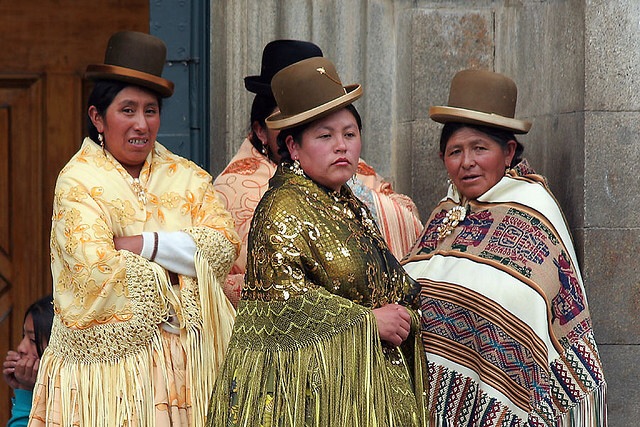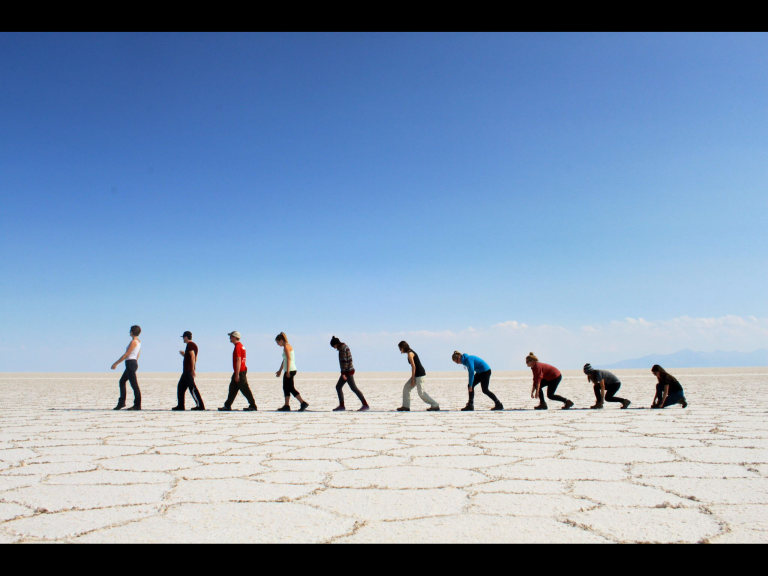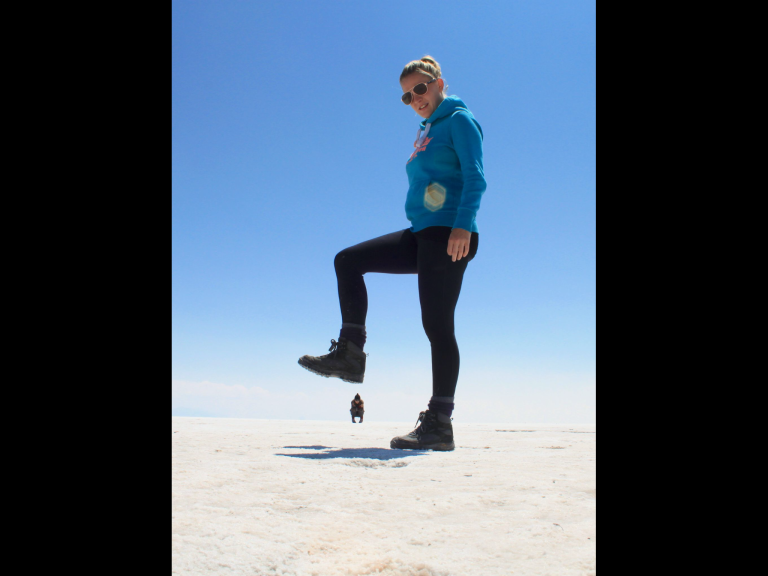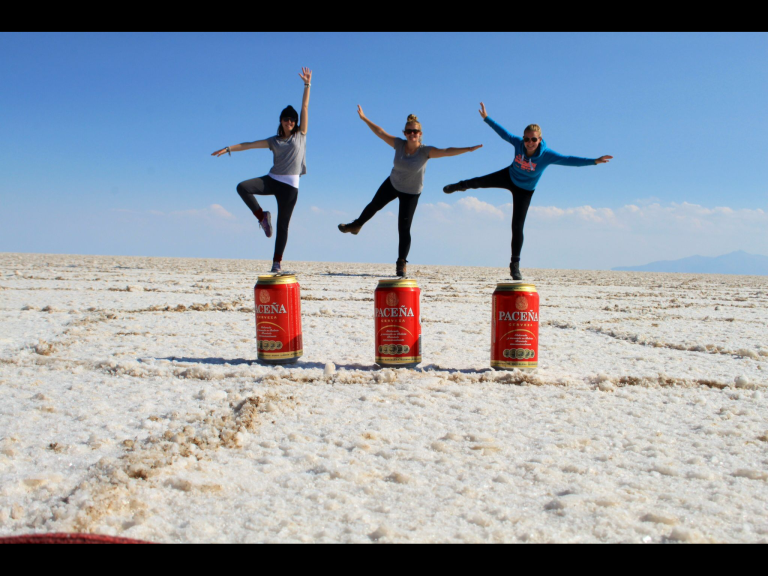The journey started in the early hours of the morning, in a bus terminal at the arse end of Peru waiting for a connecting bus to Copacabana (Bolivia).
Border crossings always vary, some are easy and some are real sketchy – this crossing happened to be pretty sketchy! Two separate immigrations later, a lot of unhappy faces behind booths and zero acknowledgment we assumed we were checked out of Peru. We then had to walk to Bolivia! Weirdest experience and a first for us as usually we are driven over the border. One stamp later and we were officially in Bolivia – our second country in South America.
Our first stop was Copacabana, the original Copacabana, on the shores of Lake Titicaca. There is probably no other name that conjures an image of tropical paradise (sparkling ocean, fabulous beach, beautiful people) quite so strongly as Copacabana. So it is understandable that a visit to Copacabana should fizzle with excitement.
Unfortunately, Copacabana, Bolivia, doesn’t quite live up to its more famous counterpart in Brazil. That’s not to say it isn’t a charming and tranquil town with a dramatic location overlooking the huge blue waters of Lake Titicaca. It’s just that it fails to excite the imagination in the same way that I’m sure the other Copacabana does.

Lake Titicaca however is a wonder all to itself. Classed as the highest navigable lake in the world at an impressive 3800 meters above sea level. It’s huge, I’m talking ginormous – it would be an easy mistake to assume it was the ocean!
We got ourselves a great deal at a HOTEL (not hostel) right opposite the lake at £7 a night. It was pure luxury to us budget travellers with two huge double beds, a balcony and a buffet breakfast – we had struck gold! The incredible views over the lake allowed us to watch some gorgeous sunsets, filling the sky with the brightest oranges and stunning reflections on the water! Unforgettable.
Lake Titicaca is home to many islands with the most famous being Isla del Sol (island of the sun). We took a late boat over to see the island for ourselves – unfortunately due to our lack of planning we only got to spend an hour exploring! The boat ride and a quick glimpse of the island was more than satisfactory for us, but you are able to stay over night here and hike from one end of the island to the other. Maybe next time.
One great thing about us taking this short but sweet journey was our first meeting with Kendall and Leah, our California girls, who will come to appear a lot more during our Bolivian adventure.
After two nights living in luxury on the doorstep of lake Titicaca it was time to move on and head to La Paz, the highest and most popular city in Bolivia. The bus between Copacabana and La Paz sure was different to any other journeys we’ve done so far. Half way through we got off the coach, leaving all our belongings behind and boarded a boat to be taken to the other side of a river. There is no bridge, so the only way for our coach to join us on the other side was for it to board a wooden, unstable looking ‘barge’ and precariously make it’s way to us. Nerves where a’rumbling as the rickety boat tipped and swayed over the waves. We later found out we have to disembark the coach as previous calamities have occurred – oh great!
Anyway we made it to La Paz in one piece but what greeted us was utter chaos. A city comparable to Bangkok, honking horns, people everywhere and houses built on top of houses as far as the eye could see – it was not what we were expecting.
We checked into Wild Rover, a notorious party hostel and somewhere we’d usually hate staying – we love our sleep!
However this turned out to be our best decision – we were blessed with a room far away from the bar so sleep was still achievable, the hostel was clean, with good food and our new friends, our California girls were also staying there!
La Paz is full of markets and during the weekends has one of the biggest I’ve ever seen, taking up over 45 blocks! We shopped, explored and even enjoyed a free walking tour put on by a company called The Red Cap. This was a great way to see the city and get a real understanding of what goes on from a locals perspective. We learnt that La Paz really has it all from a prison that is a complete shambles inside and is run by the inmates, to a witches market where llama foetuses are hung from the ceilings and are seen as good luck to traditional dressed women balancing men’s bowler hats on their heads.

The story of the bowler hats was one we will all remember and one in which we love that the tradition still stands. It goes a little like this;
Apparently in the 1920’s there was a shipment of bowler hats from London to Bolivia for the British railway workers. The hats proved to be too small, or the wrong colour, or something or other, so they were tarted up a bit with tassels and marketed to women. It was not the upper class women however who took the bait. The women who embraced this new fashion were the Aymara and Quechua women who had recently migrated to the big city of La Paz. From there the fashion spread among both the Quechua and Aymara women of Bolivia and southern Peru, and, so I’ve read on the Internet where we know everything is true, as far north as the indigenous women of Ecuador. Either way it is lovely for me to be able to google “bowler hats in Bolivia” and get some answers. I find it delightful and every traditional hard working women I saw made me smile and admire her. Flat shoes, alpaca leg warmers, full flowing skirts to accentuate her waist, a blouse and sweater, a wide thick shawl, and a bowler hat. Why not?! It takes a lot of practice, and a special elegance to balance a bowler hat on the top of your head, and depending on the angle of the hat on ones head merits there marital status (apparently).
La Paz turned out to be a cool city that the three of us really enjoyed and of course we did involve ourselves in the notorious Wild Rover parties and had a seriously fun night!! If you ever find yourself in a Bolivia – give Wild Rover a go!
We booked our salt flat tour from La Paz using a company called Kanoo Tours and more specifically Red Planet. It was a difficult task sifting through the hundreds of tour companies that offer the infamous salt flat excursion. Many are bad, with non English speaking guides, terrible food, really poor accommodation and the risk of having a drunk driver is common in Bolivia! Red Planet was recommended to us by a few people and it was one of the best and worth while recommendations we have had along this trip. They were wonderful and exceeded all our expectations – we even had a English speaking guide (which is rare)!
Let me start from the beginning;
Now as a five with Kendall and Leah we decided to do the Salt Flat tour altogether and book with Red Planet. Nothing’s ever easy and we quickly found out that the bus to Uyuni where the tour begins had only two seats left but the salt flat tour had space – disaster, this meant we could do the tour but we couldn’t get there! The three of us put our thinking caps on, well more specifically Fran and we jumped in a cab to the local bus station to see if we could book and brave one of those buses to Uyuni. On the journey their Fran’s cap kicked in and she came up with the idea of asking our hostel whether they have spaces left on the tourist bus as sometimes companies reserve a number of seats for hostel tour agencies. Unfortunately that wasn’t the case but she was really on our side and was working hard to find us a way to get us there. With that in mind we jumped in another cab back to Red Planet to reserve and pay for our Salt Flat tour so we didn’t loose our places. First success – now we were just praying for a bus. The lady at the hostel saved our bacon, and turns out another 40ish people as the bus company put on an extra tourist bus to Uyuni – which they rarely do! Persistence was key and it paid off, Phew it was time to get excited!!
The journey to Uyuni is a bad one and for around 4 of the 10 hours the bus is off-roading it through the rocky desert! It’s a vibrating hell and you can’t do anything but hold on. Literally shaken up we made it to the desert town of Uyuni – a very strange and derelict place. Thankfully we were only here for a few hours before our tour started, you wouldn’t want to be here any longer.
Fran, Leanne and I have opted for the tour to drop us at the Chilean border which makes our route through to Argentina much smoother. We organised our bags so our warm clothes were easy to access, put our walking boots back on our feet which I can honestly say did not slip back on after Salkantay and felt excited to get going.
Three days, five people, one jeep: welcome to the Bolivian desert
With the bags packed in the lobby of the tour company, we met our driver and noticed that he had no GPS, no compass and no map. No problemo! What’s the worst that could happen? It’s only a desert! The five of us jump into Eber’s ride and set out. After all the horror stories you read about, you sniff for booze and cross your fingers he isn’t drunk, and that he knows how to fix the Land Cruiser in case of a break down.
Then we’re off and were heading out in the direction of the desert, but before arriving he makes a stop on the edge of town for the first of many photo ops: the train cemetery. As Uyuni, the town, gives way to Salar de Uyuni, the desert, there is an image straight out of the old west. There are old train cars and locomotives half buried, rusting, sporting some graffiti and baking in the sun, just waiting to be trampled on and explored.
Finding ourselves all too eager to play our best Bond impression, we hopped onto the top and leapt from train car to train car.
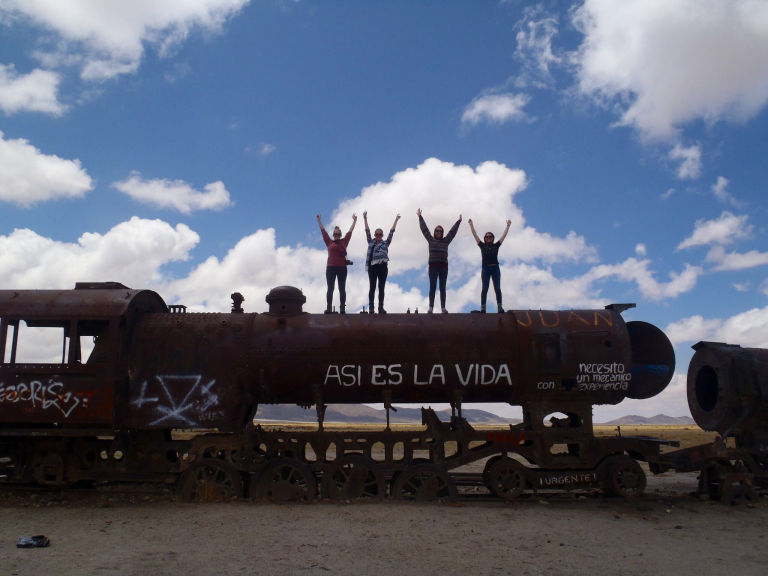
After playing 007 for a spell, it’s out into the stark, whiteness of the Bolivian salt desert; no turning back now and it didn’t take long for the surreal nature set in.
There’s something about the vast amount of blue sky at this altitude that makes you feel so tiny and insignificant. It feels both dangerous and strangely thrilling to think of yourself as nothing more than a speck.
Now imagine yourself standing in a white room; I mean completely white: all the same shade of white and no shadows. Now add in a hot, bright sun over your head and a crisp breeze bringing with it just enough unfamiliarity to tell you you’re truly somewhere unique. You are standing in the Bolivian Salt flats, aka Salar de Uyuni (ooo-you-knee). This is a truly unforgettable and likely a once in a lifetime journey over a landscape that has a type of beauty and colour just not found anywhere else on the planet!
At over 3600 metres above sea level, the prehistoric lake bed of Salar de Uyuni covers a distance of 12,000 square km. When the original lake dried up under the fierce sun, it left behind puddles of water and a huge amount of salt deposits due to the water’s high salinity.
The Salar contains over half of the world’s lithium reserves (currently being extracted) and is the largest salt flat in the world.
The further we went, the whiter it became; blindingly white. We drove for at least an hour and it felt as if we hadn’t even covered a quarter of the flats. We were all mesmerised by its shear scale and weirdness!
Lunch was served to us from the back of our 4×4 outside a strange looking restaurant made completely from salt. Where in the world were we – surround by nothing, in the middle of no where eating chicken and drinking Fanta – what is life?
It was then time for what we had all been waiting for – the crazy perspective photos. Due the scale of the flats you are able to capture some real funny photos so of course we had a blast doing this. Eber was amazing and set us up in two poses that are insanely cool.
Then we were let loose with our cameras and took some of the craziest shots! Of course the standard jumping photos came out but we also had a lot of fun with some props that we brought along!!
That will forever be one of the most hilarious photo shoots in all our lives.
There are other salt flats in the world but this one is heralded as the largest, and because it once was a body of water, it has ‘islands’ scattered about. After another long drive we made it to ‘Fish Island’ which is covered in the biggest cacti I have ever seen. We hiked to the highest part of the island and were able to take a 360 degree look round. We were standing on a mound of dead coral reef that was once 200 meters under water and is now covered in cacti! That fact alone made us realise how big this lake once must have been! The island is now completely surrounded by flat white, salt, as far as the eye can see. A completely surreal feeling.
As the sun began to set in over the mountains, which were now appearing in the distance, we all jumped out of the 4×4 and said our goodbyes to the most surreal place we had ever visited – and obviously took some photos!

We started to approach a cluster buildings, one of which will be home for the night. Eber tossed bags down from under the tarp-covered roof of the vehicle and we stretched our legs after the bumpy ride. This ‘hostel’ was completely made of salt: salt floors, salt roof, salt walls, tables, chairs and even the beds, although they do have a non-salt mattress on them and the toilets are just toilets, thankfully.
The five of us felt as if we had been given the master suite and slept remarkably well regardless of the location. We were quite literally in the middle of no where with no one but our other Red Planet amigos, we had a lot of fun that night, had a great dinner and then stared in awe at the most incredible starred filled sky- what lucky people we were! It was close to freezing that night so we were more than ready to get under our 5 woollen blankets and rest up for the next day.
After an early wake up call and a good breakfast, the first part of the drive began a lot like yesterday, flat and sparse.

A few hours passed and the mountains that were creeping into view yesterday suddenly don’t seem so unreachable. As the vehicle sped across the flatness, the colour of the ground began to change, becoming slightly pink and then red with more and more loose gravel. The salt portion of the desert has passed.
We were heading towards a huge volcano with a snow capped peak – please don’t make us climb it was all that I was thinking! Thankfully we didn’t but we did have a lot of fun jumping around the volcanic rock that had been blown miles from the crater – more climbing – such kids!
For hundreds of miles, this region is desolate, empty, and enormous – and there’s a strong likelihood that you would get completely lost and probably die if you tried to journey through it alone. Within hours, we were off any recognisable path and seemingly following an invisible track that only the drivers could see.

Deep, steep canyon drops flanked by cacti, rocks and dust quickly gave way to dry scrub land that stretched indefinitely in every direction. Eber drove through the nothingness like he was driving to his local store, he knew exactly where he was going, which routes not to take and which were safe – we felt as if we were in good hands. He also put up with our constant girly singing and backseat dancing which we will forever love him for!
Occasionally we’d spot a herd of llamas or vicuñas, but for most of our day, the landscapes and bad singing ruled over our eyes and ears.
The terrain of the Bolivian desert is, unsurprisingly, rather dusty. The altitude there varies, but we were usually at around 4000m – so when the sun was shining, it was also pretty warm. And thus a problem occurred, dust in the car was on no ones wish list but we also didn’t enjoy the overheating issue. The amount of window opening was therefore in constant flux. Every time we caught up to another vehicle or passed a cloud of dust, up went our windows – only to immediately pull them open again when we deemed it safe.
I, for one, definitely wasn’t expecting so much lake action. But every hour or so, a huge body of water would appear on the horizon, the jeep would slow, and we’d stare at colours that seemed like they simply couldn’t be natural. Surely someone was wreaking havoc with a paint pot?
The first we saw and actually the location for the most surreal lunch stop in the world was a vast lake scattered with thousands of pink flamingos. The still water mirrored the surrounding mountains and made for an unforgettable stop and some incredible photographs.
Another lake, just inside the strangest most remote national park in the world was blood red and again scattered with thousands of pink flamingos. It’s actually red because of the minerals in the water. The flamingos were enchanting – none of us had seen so many in the wild before! They were clearly totally unbothered about standing in the middle of a blood red lake, feasting on algae, while the surrounding tourists attempt to take photos in the gale force winds.
In the midst of these jaw-dropping natural scenes, there are a number of animals maintaining an existence – surprising, seeing as there’s barely any vegetation for them to feed on. The times we spotted condors circling in the sky above was understandable, the herds of grazing llamas, a little less so, but the flamingos – why on earth are they here?
Well apparently the Salar de Uyuni is actually a major breeding ground for four different species of flamingos, and every year they migrate from the north to the exact same lakes.
Once we had seen enough flamingos to last us a life time we headed to a place that looked like a Salvador Dali painting – The Rock Tree. A strange wind shaped rock formation that resembles more of a freestanding tree than a rock. We took some muscle man pictures that looks as if we are holding the rock up and then as we began to worry that we will wear out the shutter on our cameras we decided to give rock climbing one last go 😉
Those once distant mountains and volcanos are now all that our drive consists off and the pinks, blues, oranges and yellows of mineral deposits and volcanic rock have become ultra-brilliant. Beautiful flamingos bathe at the edge of crystal clear ponds as white smoke puffs from the tops of sleeping volcanoes. It is one of the most sparse but beautiful landscapes I have ever had the chance of exploring.
The last stop of the day were the impressive yet smelly geysers. A cluster of holes in the ground thrash out sulphur at an alarming rate. The noise is indescribable but walking past some of the big ones you are unable to hear one another. Of course the sulphur smelt to high heaven which made us appreciate the impressiveness from a fair distance but we did have a walk through them to recognise the heat that spills out! It provided a welcome blast of heat in the cold desert. The steam that gently warms your face will, however, also melt your shoes, so watch your step!
The sun fades and the next cluster of buildings was upon us. We were promised a really basic hostel, where the temperature would reach below zero. We were prepared with our sleeping bags and low expectations but it turns out they were an unnecessary extra piece of luggage as the hostel provides loads of blankets and the now brick walls sheltered us from the chilling winds.
That night we got to spend the evening in some natural hot springs that were just outside our hostel. We had to make a mad dash from the hostel to the springs in just our bikini and coat but once we were in that 38 degree water it was worth the pain. That hour we spent in the hot springs under the billions of stars with our wonderful Cali girls was beyond magical. We star gazed, watched shooting stars and chatted the night away – such an unforgettable experience.

Still had to wear our woolly hats
I can say we slept like babies that night!
Another early start, we braved the cold morning and loaded our 4×4 for the last time. We were all pretty emotional as this epic trip was about to come to end and more to the point it was time for us three and our Cali girls to go our separate ways 😦
There was time for one more lake and one more sing song before the end and this time it was an incredible green colour! Seeing such insane natural wonders will always take my breath away and understandably we were mesmerised again!
The time came for us to head to the Chilean border and the girls to head back to Uyuni. One of the worst things about travelling is this very moment, the goodbye and the promise to see each other again.. I guess another trip to Los Angeles is on the cards 🙂
The Bolivia/Chile border, the most remote border crossing we have ever been to. The little building you see in the middle of nowhere is the border crossing. We collected our belongings, said goodbye to our driver and headed to the hut to take care of the normal formalities. Then it was time to find a patch of dirt out of the bitter wind and wait for a connecting bus to the Chilean town of San Pedro de Atacama.
The journey quickly became one of the best rides of our lives. The bus descends and keeps descending, and with each passing hundred meters, life and colour begin to flow back into your cold veins. A rush of energy like a warm blanket covers your body; descending a thousand meters, then two thousand, a smile creeps across your face as you think about where you just came from. And just like that, the bus spits you out in the centre of a busy Chilean town, and it’s all over. Country number 3.
The salt flats tour from Uyuni is hands down one of the most bizarre trips I’ve ever taken. But what I hadn’t realised before our trip began was how little time you actually spend on the salt flats themselves. Bolivia, as ever, has been underselling itself.
It’s not just about perspective-skewed photos while surrounded by salt; it’s also bright pink flamingos, lakes, mountains, hot springs, llamas, rocks, geysers, sand dunes, and a few more flamingos.
In short, this area of Bolivia holds the most spectacular array of contrasting scenery that I’ve ever seen in such a short space of time.
And my words will simply not do this place justice.


